
|
|





 |
|
||||||||
 |
 |
 |
 |
||||||

|
|||||||||
|
|
 9 Jun 2006, 11:11 PM 9 Jun 2006, 11:11 PM
Post
#1
|
|
|
Administrator Group: Admin Posts: 118175 Joined: 3-June 05 From: Athens, Greece Member No.: 1 Zodiac Sign:  Gender:  |
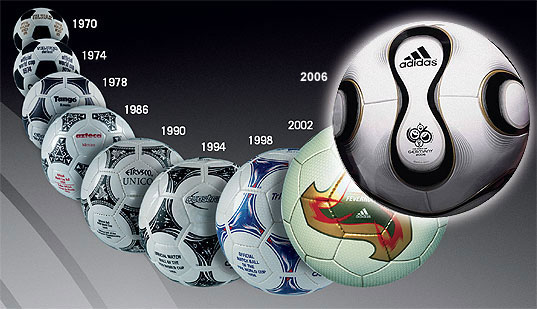 Interesting, isn't it ? -------------------- |
|
|
 |
 10 Jun 2006, 05:50 PM 10 Jun 2006, 05:50 PM
Post
#2
|
|
 Music Moderator Group: Elite Members Posts: 1564 Joined: 14-October 05 From: The Edge Of The Deep Green Sea Member No.: 492 Zodiac Sign:  Gender:  |
The First World Cup Soccer Ball
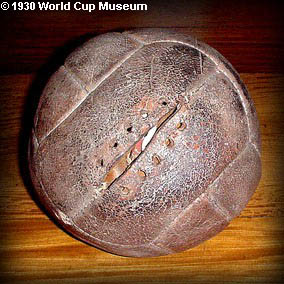 it was like this one.... 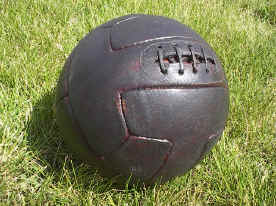 1930 World Cup Soccer Ball of "Tiento" One of the two soccer balls used in the first 1930 World Cup final between Argentina and Uruguay is shown above. This leather football was used in the final match and taken by an Uruguayan team player. It may have even played a part in the outcome of the first world cup in 1930. Argentina and Uruguay could not agree on which ball to use. So they decided to use an Argentinean ball the first half and a ball supplied by Uruguay the second half. As it turned out, Argentina was ahead at halftime 2-1. However, Uruguay came back to win the match in the second half 4-2 using their ball! The first "official" FIFA World Cup soccer ball, as we see from the 1st post, was the Adidas Telstar, used in the 1970 World Cup at Mexico. Telstar - Mexico, 1970 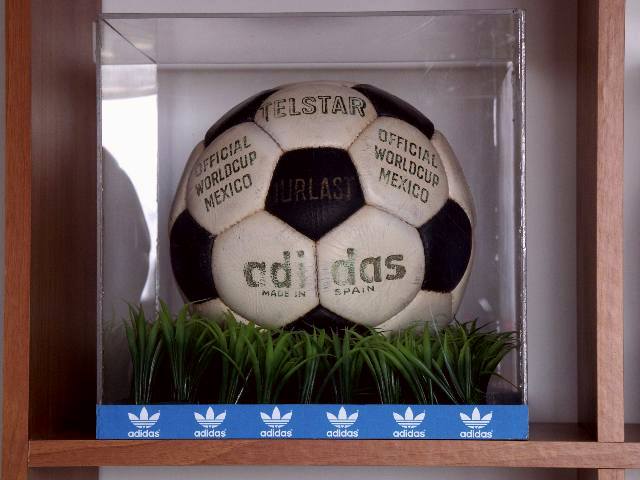 Adidas started to make soccer balls in 1963 but made the first official FIFA World Cup ball in 1970. The first ball with 32 black and white panels. The Telstar (Star of Television) was more visible on black and white televisions (1970 FIFA World Cup Mexico was the first to be broadcast live on television). Telstar Durlast - West Germany, 1974 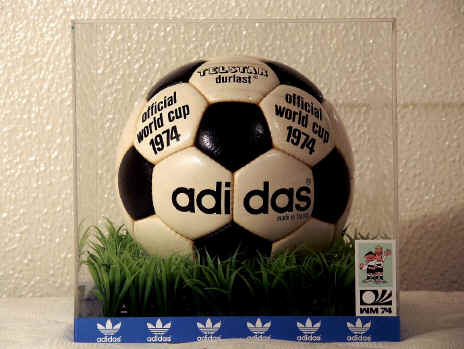 Two adidas match balls were used for Germany ‘74. Telstar made a repeat appearance with new black branding replacing the previously gold branding. The materials and techniques used in this ball were identical to those used four years earlier. Tango Durlast - Argentina, 1978 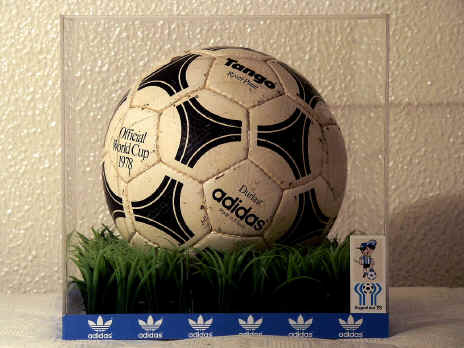 Soccer ball design experienced another revolution in 1978 with the introduction of the Adidas Tango. Adidas had created what would become a ‘football design classic’. Twenty panels with ‘triads’ created the impression of 12 identical circles. For the following five FIFA World Cup tournaments, the match ball design was based on this design. Tango featured improved weather resistance qualities, and took its inspiration from the deep passion, emotion and elegance of Argentina. The Tango was also used at the Olympic Games and in the European Cup. Tango Espana - Spain, 1982 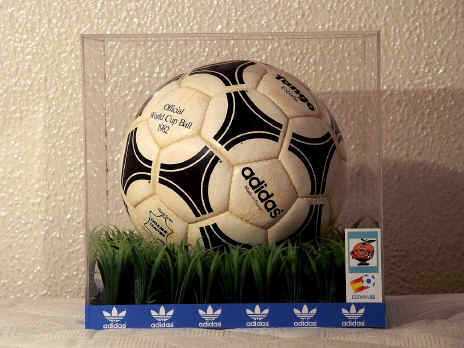 Adidas introduced a new ball which had rubber inlaid over the seams to prevent water from seeping through. The first ball with water-resistant qualities. General wear from kicking however meant the rubber began to wear after a short time and needed to be replaced during the game. The last genuine leather world cup ball. Azteca - Mexico, 1986 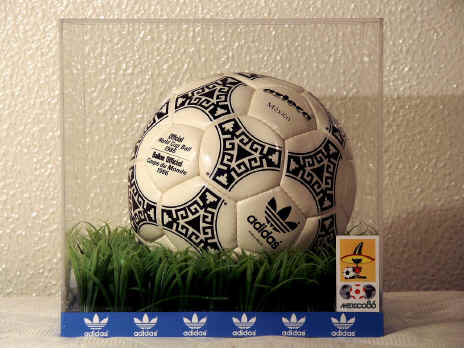 A completely new model was developed for the World Cup in Mexico. The Azteca Mexico was a hand-sewn ball, and for the first time, synthetic material, rather than leather was used to produce it. The ball consisted of an outer polyurethane wearing coat and three lower layers, which mutually complemented one another with their different "Adicron" structures. These were intended to ensure the ball's resistance, ability to retain its shape and its waterproof properties. With its never-before-achieved performance on hard ground, at high altitude, and in wet conditions, Azteca represented a massive leap forward for the game. Its elaborately decorated design was inspired by the hosting nation’s native Aztec architecture and murals. Etrusco Unico - Italy, 1990 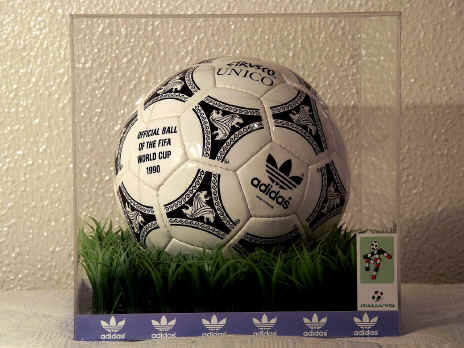 This ball was a high-tech product which was manufactured entirely from quality synthetic fibers. The lowest covering consisted of textiles impregnated with latex for form stability and resistance to tearing, the neoprene layer made the ball water-tight and the outer skin made of polyurethane layers was used for abrasion resistance and good rebound properties. The name and intricate design took their inspiration from Italy’s magnificent, ancient history and the contributions and fine art of the Etruscans. Three Etruscan lion heads decorate each of the 20 Tango triads. Questra - USA, 1994  This ball was enveloped in a layer of polystyrene foam. This not only made it more waterproof but allowed the ball greater acceleration when kicked. The new game ball felt softer to the touch. Improved ball control and higher velocity during play. Tricolore - France, 1998 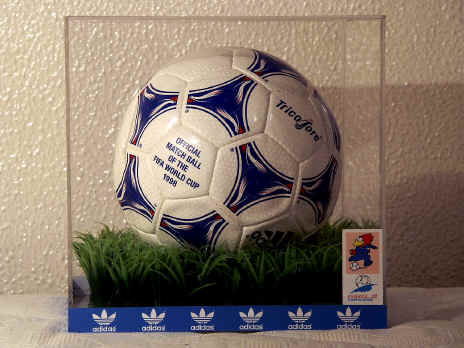 By 1998, FIFA World Cup France was played with a ball which sported the French red-white-blue tri-color. A complete departure from the old traditional black and white pattern. The first official World Cup soccer ball that was in color. The Tricolore used underglass print technology with a thin layer of syntactic foam. This new foam material had better compression and more explosive rebound characteristics, making the ball softer and faster than its predecessor, Questra. Fevernova - Korea/Japan, 2002 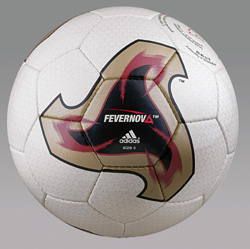 The adidas Fevernova was the first World Cup match ball since 1978 to break with the traditional Tango design introduced in 1978. It is three millimeters thick (11 layers). This includes a special foam layer with tiny gas filled balloons imbedded in a syntactic foam. The foam is based on an abrasion resistant polyurethane made by Bayer called Impranil® polyurethane. The outer cover of the ball consists of a combination of special synthetic polystyrenes (polyurethane) and natural rubber. Embedded within the layers are equal sized, highly elastic, exceptionally resistant gas-filled microcells. The inner lining consists of a tightly woven network of knitted, synthetic Raschel fabric. The spongy layer has high modulus of compression, with a good elastic memory. These layers give the Fevernova improved rebound characteristics, which convert foot strike into ball acceleration. The outer layer of the ball is made of a particularly so that the ball can withstand exceptionally tough treatment. All of this combines to give the ball greater durability. According to Adidas, the surface of the new ball converts applied energy evenly at every point. Theoretically, this gives a more calculable, flight path with advanced players. A mesh inner layer provides strength that limits deformation when the ball is kicked and helps the ball remain spherical in flight. Any distortion of the round shape of a ball leads to an uneven airflow around the it, making it veer off course. The ball can travel up to speeds of 81 mph. The ability of players to swerve the ball will not be effected since the spin of the ball causes the intended curving. The foot is the key to transferring the foot's force . The presence of gas filled microcels insures that the applied force is transferred to the ball. The bubbles allow the ability to kick the ball without too much resistance in which the ball does not absorb the applied energy. This converts the applied force (kick) into ball acceleration. Teamgeist - Germany, 2006 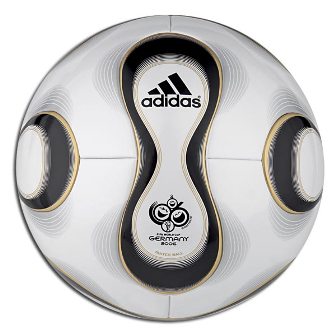 The ball differs from previous designs in having just 14 curved panels, rather than the 32 (12 pentagons and 20 hexagons) that has been standard since the 1970 World Cup. In another first, the panels are glued together rather than stitched. It is claimed to be rounder and to perform more uniformly regardless of where it is hit, and being almost waterproof it also doesn't change performance as much in the wet. 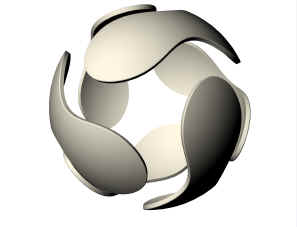 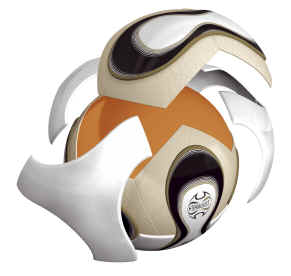 Traditional 32 panel hand stitched balls have a wider target zone meaning accuracy is hard to consistantly achieve. The new 14-panel design has resulted in a ball with the most consistent performance characteristics ever, enabling the players to show their true skills. There are fewer seams, so the ball is rounder and performs more uniformly, regardless of where it is hit. The more perfect the sphere is, the more balanced it will be, offering greater accuracy due to the predictability of its flight. The new panel shape harmonizes the energy displacement and minimizes the amount of corners, while the larger panels allow for a cleaner kicking area. Perhaps the biggest difference the players will find with the new balls will be how they play in the wet. Normally, a wet and heavy ball behaves quite differently from a dry one. It flies slower through the air, has a lower bounce and is more difficult to curl. A patented Thermal Bonding technology makes the new ball virtually waterproof with identical performance characteristics wet or dry. The FIFA Approved Standard for water absorption stipulates no more than a 10% weight increase – the Teamgeist’s has less than 0.1 % weight increase. Similarly, it has significantly improved on all standards for uniformity of rebound and pressure retention and shape and size retention. Clever design and technologies has enabled Adidas to reduce manufacturing tolerances to a new level. Teamgeist Overview: New panel shape and carcass construction leads to increased precision for straight and curved shots. With the Teamgeist, every pass, every shot, every dribble, is as consistently accurate, powerful and fast as the last. Improved all weather performance for consistent play in any condition. Revolutionary Panel Shape: eliminates surface irregularities to create a perfectly round ball for greater accuracy. New Carcass: improves accuracy and power. Complete Underglass Print: significantly decreases abrasion of design. Thermal Bonding: seamless panels create a smooth, consistent kicking surface. The embedded circuitry to alert referees when it has crossed the goal-line is not included. (!!) [source]SoccerBallWorld[/source] -------------------- |
|
|
 NickTheGreek Ball Designs 9 Jun 2006, 11:11 PM
NickTheGreek Ball Designs 9 Jun 2006, 11:11 PM
 hlias_gr Do you know the weight of the balls? 10 Jun 2006, 08:00 AM
hlias_gr Do you know the weight of the balls? 10 Jun 2006, 08:00 AM

 mak very interesting Nick
QUOTE(hlias_gr @ 10... 10 Jun 2006, 03:11 PM
mak very interesting Nick
QUOTE(hlias_gr @ 10... 10 Jun 2006, 03:11 PM
 NickTheGreek mak it is good to have Moderators that are equally... 10 Jun 2006, 05:54 PM
NickTheGreek mak it is good to have Moderators that are equally... 10 Jun 2006, 05:54 PM
 mak i'm trying thanx
but not like you.....
you ... 10 Jun 2006, 06:01 PM
mak i'm trying thanx
but not like you.....
you ... 10 Jun 2006, 06:01 PM
 mak The Golden Teamgeist for 2006 FIFA World Cup™ Fi... 20 Jun 2006, 06:20 PM
mak The Golden Teamgeist for 2006 FIFA World Cup™ Fi... 20 Jun 2006, 06:20 PM
 NickTheGreek looking nice, thank you ! 20 Jun 2006, 07:59 PM
NickTheGreek looking nice, thank you ! 20 Jun 2006, 07:59 PM
 sarkey Thanks Mak and Nick very informative posts. Over h... 21 Jun 2006, 10:28 AM
sarkey Thanks Mak and Nick very informative posts. Over h... 21 Jun 2006, 10:28 AM  |

|
Lo-Fi Version | Time is now: 23rd June 2025 - 10:10 PM |
| Skin and Graphics by Dan Ellis and Anubis. Hosting by Forums & More � 2005-2011. |